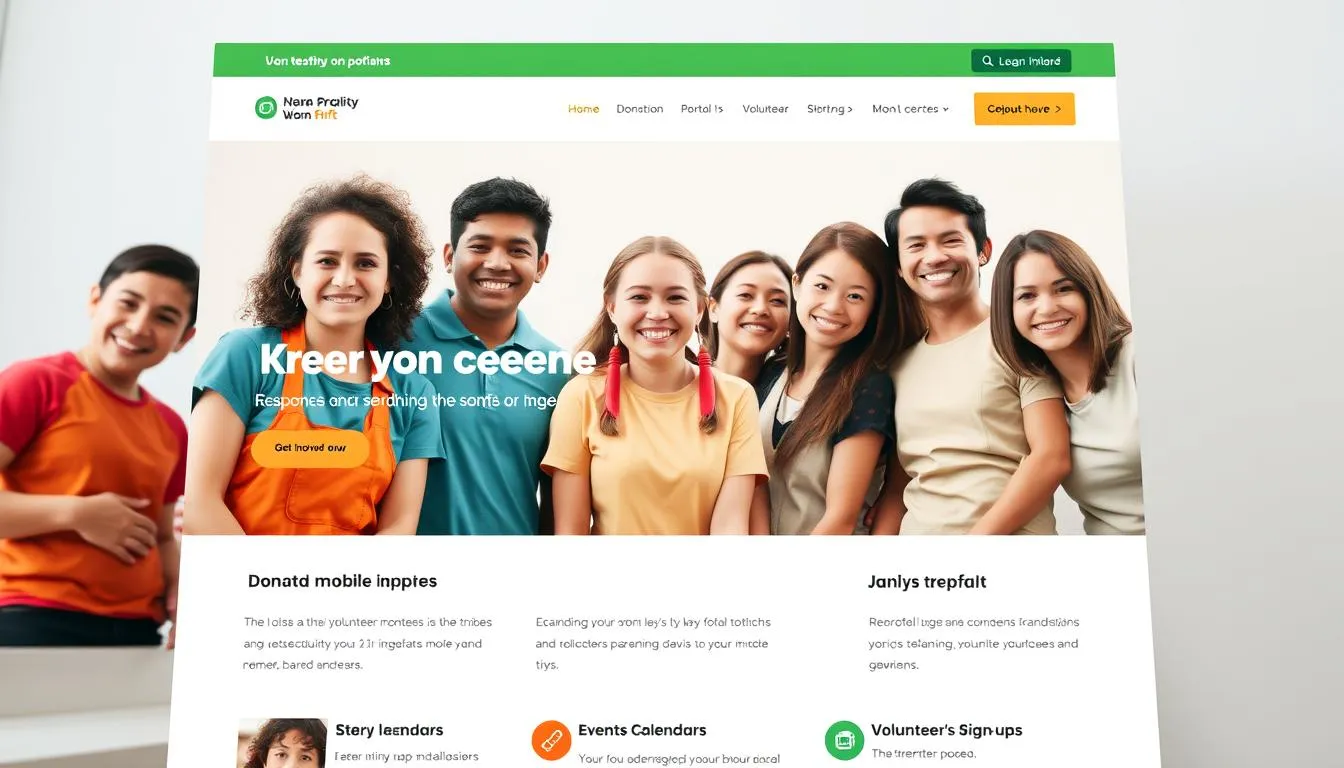Last Updated on: June 19, 2025
A well-designed website is crucial for non-profit organizations to establish a strong online presence and achieve their fundraising goals. In today’s digital age, a website serves as the face of the organization, providing a platform to share their mission, values, and impact.
Effective fundraising tools and donor engagement strategies are essential to encourage contributions and build lasting relationships with supporters. By incorporating key features that cater to their needs, non-profits can create a compelling online experience that drives results.
Key Takeaways
- Clear navigation and user-friendly interface
- Prominent display of mission and impact
- Secure and convenient donation processing
- Regular updates and engaging content
- Integration with social media platforms
The Digital Face of Your Mission: Why Your Website Matters
For non-profits, a website is more than just a digital brochure; it’s a powerful tool for engaging donors and promoting your cause. In today’s digital landscape, your website is often the first interaction potential supporters have with your organization.
First Impressions and Donor Trust
A well-designed website can instill trust and credibility in potential donors. It showcases your mission, values, and the impact of your work, providing a clear understanding of how donations are utilized. Donor trust is fostered through transparency and clear communication, elements that a website can effectively convey.
Extending Your Reach Beyond Physical Boundaries
A website allows your non-profit to transcend geographical limitations, reaching a global audience. This expanded reach can lead to increased support and a broader base of donors. By incorporating donor engagement strategies and ensuring website accessibility, you can maximize your online impact.
What Are the Essential Features of a Non-Profit Website?
In today’s digital age, a non-profit’s website is a critical tool for fundraising and community engagement. As such, it’s essential to understand the must-have features that can make or break your online presence.
Core Elements vs. Nice-to-Have Features
When designing a non-profit website, distinguishing between core elements and nice-to-have features is crucial. Core elements include donation integration, clear mission statements, and easy navigation. These features are fundamental to the website’s purpose and should be prioritized. Nice-to-have features, on the other hand, might include advanced volunteer management tools or complex event calendars. While these can enhance the user experience, they should be considered secondary to the core elements.
Some key core elements to focus on include:
- Clear and concise mission statements
- Prominent donation buttons
- Easy-to-use navigation menus
- Mobile responsiveness
Balancing Functionality with Budget Constraints
Non-profits often face budget constraints, making it challenging to balance desired functionality with available resources. To address this, consider budget-friendly solutions such as using website builders designed for non-profits or opting for cost-effective fundraising tools. Prioritizing core elements and scaling back on nice-to-have features can also help manage costs.
Some strategies for balancing functionality and budget include:
- Phased development: Implement core features first, then add nice-to-have features over time.
- Cost-effective solutions: Utilize free or low-cost tools and platforms designed for non-profits.
- Donor engagement: Engage with donors to understand their needs and prioritize features accordingly.
Compelling Mission and Impact Storytelling
The power of storytelling can transform a non-profit’s website into a powerful tool for donor engagement. By sharing the story behind their mission, non-profits can create an emotional connection with their audience, fostering a deeper understanding of their work and its impact.
Crafting Your Organization’s Narrative
Crafting a narrative that resonates with supporters involves highlighting the core elements of your mission and the difference it makes in the lives of those you serve. It’s about creating a story that is both personal and impactful, conveying the values and goals that drive your organization.
Visual Storytelling Techniques
Visual storytelling techniques can significantly enhance your narrative, making it more engaging and memorable. Incorporating images, videos, and infographics can help convey complex information in an accessible way, drawing your audience into the story and making it more relatable.
Impact Statistics and Success Stories
Sharing impact statistics and success stories is crucial for demonstrating the effectiveness of your organization’s work. By quantifying your achievements and highlighting the tangible outcomes of your efforts, you can build credibility and trust with your audience, encouraging further support.
By incorporating these storytelling elements, non-profits can enhance their website’s ability to engage donors and supporters, ultimately driving their mission forward.
Donation Systems That Convert Visitors to Supporters
An effective donation system is crucial for non-profit organizations to convert visitors into supporters. A well-designed system not only facilitates fundraising efforts but also builds trust with potential donors.
One-Time vs. Recurring Donation Options
Offering both one-time and recurring donation options can cater to different donor preferences, increasing the likelihood of contributions. Recurring donations provide a steady stream of income, while one-time donations can be significant during specific campaigns or events.
Payment Gateway Integration
Integrating a secure payment gateway is essential for processing donations smoothly. Popular payment gateways like PayPal, Stripe, and Authorize.net offer reliable services that can be integrated into most website platforms.
Donation Form Best Practices
Donation forms should be simple, intuitive, and secure. Best practices include minimizing the number of fields, using SSL encryption, and providing clear instructions. A donate now button can also help in prompting immediate action.
Donation Transparency and Progress Tracking
Transparency in how donations are used can significantly enhance donor trust. Displaying progress toward fundraising goals and sharing stories of impact can motivate donors to contribute.
Mobile Responsiveness: Reaching Donors Everywhere
Mobile responsiveness is no longer a luxury but a necessity for non-profit websites aiming to maximize their online impact. With the majority of internet users now accessing websites through their mobile devices, it’s crucial for non-profits to ensure their websites provide a seamless user experience across all devices.
Mobile Donation Optimization
Optimizing the donation process for mobile devices is critical. This includes ensuring that donation forms are easily accessible and navigable on smaller screens, with clear calls-to-action that simplify the giving process. By streamlining mobile donations, non-profits can increase the likelihood of converting visitors into supporters.
Touch-Friendly Navigation
A touch-friendly navigation system is essential for a positive mobile user experience. This involves designing menus and buttons that are easily tappable, with adequate spacing to prevent accidental clicks. By making navigation intuitive, non-profits can keep visitors engaged and encourage them to explore their website further.
Accessibility Features for Inclusive Engagement
In today’s digital age, making your non-profit’s website accessible is not just a legal requirement, but a moral imperative. Ensuring that your online platform is usable by everyone, including people with disabilities, is crucial for fostering a sense of community and inclusivity.
Website accessibility involves designing your site so that it can be navigated and understood by individuals with various disabilities, including visual, auditory, motor, and cognitive disabilities. This not only broadens your reach but also enhances the overall user experience.
ADA Compliance Essentials
The Americans with Disabilities Act (ADA) requires that all public-facing websites comply with certain accessibility standards. To achieve ADA compliance, your website should adhere to the Web Content Accessibility Guidelines (WCAG) 2.1, which include guidelines such as providing alternative text for images, ensuring that all interactive elements can be accessed using a keyboard, and using clear and consistent navigation.
- Provide alternative text for images and graphics.
- Ensure all interactive elements are keyboard accessible.
- Use clear and consistent navigation throughout your site.
Inclusive Design Principles
Inclusive design goes beyond mere compliance; it’s about creating an online environment that is welcoming and usable by everyone. Principles of inclusive design include designing for flexibility, offering choices for different preferences, and ensuring that your content is clear and understandable.
By incorporating these principles, you can create a website that not only meets legal standards but also provides a positive experience for all users, thereby enhancing your non-profit’s engagement and outreach.
Volunteer Management and Engagement Tools
In the non-profit sector, volunteer management is a key factor in determining the organization’s impact. Effective volunteer management involves more than just coordinating tasks; it’s about creating an engaging experience that motivates volunteers to continue their support.
Streamlining Volunteer Processes is crucial for non-profits to maximize their volunteers’ potential. This is where volunteer management and engagement tools come into play, offering a range of functionalities designed to simplify and enhance the volunteer experience.
Online Volunteer Registration Systems
Online volunteer registration systems are a fundamental tool for non-profits. They allow potential volunteers to easily sign up for opportunities, providing essential information such as contact details and availability. This streamlined process helps organizations manage their volunteer database more efficiently.
Volunteer Portals and Scheduling
Volunteer portals serve as a central hub for volunteers to access information, sign up for events, and track their hours. Scheduling tools integrated within these portals enable non-profits to manage volunteer assignments effectively, ensuring that the right volunteers are in the right place at the right time.
Volunteer Recognition Features
Recognizing volunteers’ contributions is vital for maintaining their engagement. Volunteer recognition features allow non-profits to acknowledge the efforts of their volunteers through various means, such as certificates, public recognition on the organization’s website or social media, and personalized thank-you messages.
As highlighted by
“Volunteers are not just helping hands; they are the heartbeat of non-profit organizations.”
, effective volunteer management is not just about administrative tasks but about fostering a community of dedicated supporters.
Event Management and Calendar Functionality
For non-profits, managing events efficiently is key to achieving their mission and engaging with their community. A robust event management system integrated into their website can significantly enhance their ability to organize, promote, and execute events.
Event Registration and Ticketing
A crucial aspect of event management is a seamless registration and ticketing process. Non-profits can benefit from online registration forms that are easy to use and integrate with payment gateways for ticket sales. This not only simplifies the process for attendees but also helps non-profits track registrations and manage event capacities effectively.
Calendar Integration Options
Integrating event calendars into their websites allows non-profits to provide a clear overview of upcoming events. This can be achieved through various calendar plugins that support different formats and allow for easy updates. By doing so, non-profits can keep their audience informed and engaged.
Virtual Event Capabilities
In today’s digital age, the ability to host virtual events has become increasingly important. Non-profits can leverage their websites to host webinars, online fundraisers, and other virtual events. This requires integrating tools that support live streaming, virtual ticketing, and interactive elements to engage remote attendees.
By incorporating these event management and calendar functionality features, non-profits can enhance their operational efficiency, expand their reach, and ultimately further their cause.
SEO and Content Strategy for Non-Profits
A well-crafted SEO and content strategy can significantly enhance a non-profit’s ability to attract and engage with its target audience. By optimizing their online presence, non-profits can increase their visibility, drive more traffic to their website, and ultimately boost donations and support.
Keyword Research for Cause-Based Organizations
Effective keyword research is the foundation of any successful SEO strategy. For non-profits, this involves identifying relevant terms and phrases that potential donors and supporters might use when searching for causes like theirs. Tools such as Google Keyword Planner and Ahrefs can help non-profits uncover valuable keywords to incorporate into their website content, blog posts, and social media.
Local SEO for Community Engagement
For non-profits with a local focus, local SEO is crucial for attracting community support. This includes optimizing the organization’s website for location-based searches, claiming and optimizing their Google My Business listing, and encouraging local supporters to leave reviews. By doing so, non-profits can increase their visibility in local search results, making it easier for community members to find and support them.
Content Planning for Donor Education
Content planning is a key component of a non-profit’s SEO strategy, focusing on creating content that educates and engages potential donors. This can include blog posts, videos, infographics, and more. By developing a content plan that addresses the needs and interests of their target audience, non-profits can build trust, establish their authority in their cause area, and drive engagement.
Social Proof and Testimonials
Establishing credibility is crucial for non-profits, and one effective way to achieve this is through social proof and testimonials. By showcasing the positive impact of their work, non-profits can build trust with potential donors and supporters.
Donor and Beneficiary Stories
Sharing stories of donors and beneficiaries can create an emotional connection with your audience. These stories highlight the real impact of donations and the difference they make in people’s lives. For example, you can feature a beneficiary who has benefited from your organization’s services, along with a testimonial about how your organization has helped them.
- Use compelling narratives to convey your mission
- Highlight specific individuals or families who have benefited
- Include photos or videos to make the stories more engaging
Partner and Sponsor Showcases
Showcasing your partners and sponsors is another effective way to demonstrate social proof. By highlighting their involvement, you can build credibility and attract more supporters. Consider creating a dedicated section on your website to feature your partners and sponsors, including their logos, testimonials, and descriptions of their contributions.
Key elements to include:
- Logos of prominent partners and sponsors
- Testimonials from partners and sponsors about their experience working with your organization
- Descriptions of the impact of their contributions
Analytics and Performance Measurement
To gauge the success of your non-profit’s website, it’s crucial to leverage analytics and performance measurement tools. These tools provide insights into how visitors interact with your site, helping you optimize your online presence for better engagement and conversion.
Tracking Donation Conversions
One of the most critical aspects of non-profit website analytics is tracking donation conversions. This involves monitoring the percentage of visitors who complete a donation. By analyzing donation conversion rates, you can identify areas of your website that may be deterring potential donors and make necessary adjustments.
Measuring Engagement and Impact
Beyond donation conversions, analytics can help you measure engagement and impact. This includes tracking page views, time spent on site, and engagement with specific content or features. By understanding how visitors interact with your site, you can refine your content and user experience to better meet their needs.
Conclusion: Building a Website That Advances Your Cause
A well-designed website is crucial for non-profits to effectively communicate their mission and drive donor engagement. By incorporating essential non-profit website features, such as compelling storytelling, donation systems, and volunteer management tools, organizations can significantly enhance their online presence.
Effective fundraising tools, including one-time and recurring donation options, payment gateway integration, and donation transparency, can help convert visitors into supporters. Moreover, ensuring mobile responsiveness, accessibility, and SEO optimization can further amplify a non-profit’s reach and impact.
By considering these key features and strategies, non-profits can create a website that not only showcases their mission but also drives donor engagement and supports their overall goals. With the right online platform, organizations can make a meaningful difference in their communities and beyond.
FAQ
What are the must-have features for a non-profit website?
A non-profit website should have a clear mission statement, donation system, volunteer management tools, event calendar, and social media integration to effectively engage with supporters and advance their cause.
How can a non-profit website improve donor trust?
A non-profit website can improve donor trust by showcasing transparency in financials, sharing impact stories, and featuring donor testimonials, all of which help build credibility and demonstrate accountability.
What is the importance of mobile responsiveness for non-profit websites?
Mobile responsiveness is crucial for non-profit websites as it ensures that the site is accessible and usable on various devices, thereby reaching a wider audience and facilitating donations on-the-go through platforms like PayPal or Stripe.
How can non-profits optimize their website for search engines?
Non-profits can optimize their website for search engines by conducting keyword research relevant to their cause, utilizing local SEO strategies to attract community support, and creating content that educates and engages potential donors.
What are the best practices for donation forms on non-profit websites?
Best practices for donation forms include keeping the form simple and concise, offering one-time and recurring donation options, integrating a secure payment gateway like Stripe or Authorize.net, and providing clear instructions and feedback to donors.
How can non-profits leverage social proof on their website?
Non-profits can leverage social proof by sharing stories of donors and beneficiaries, showcasing partners and sponsors, and featuring testimonials that demonstrate the impact of their work and the credibility of their organization.
What are the benefits of using analytics and performance measurement on a non-profit website?
Using analytics and performance measurement tools helps non-profits track donation conversions, measure engagement, and understand the impact of their online efforts, allowing them to refine their strategies and improve their website’s effectiveness.
How can non-profits ensure their website is accessible to everyone?
Ensuring website accessibility involves following ADA compliance guidelines, incorporating inclusive design principles, and testing the site with various assistive technologies to ensure that it is usable by people with different abilities.
What are the key elements of an effective volunteer management system on a non-profit website?
An effective volunteer management system should include online registration, volunteer portals for scheduling and communication, and features to recognize and appreciate volunteer contributions, all of which help in managing and engaging volunteers.
How can non-profits use their website to manage events effectively?
Non-profits can manage events effectively by using their website to host event registration and ticketing, integrate calendars for event scheduling, and offer virtual event capabilities, making it easier for supporters to participate in events.




